
Woolwich Dockyard was an English naval dockyard along the river Thames at Woolwich in north-west Kent, where many ships were built from the early 16th century until the late 19th century. William Camden called it 'the Mother Dock of all England'. By virtue of the size and quantity of vessels built there, Woolwich Dockyard is described as having been 'among the most important shipyards of seventeenth-century Europe'. During the Age of Sail, the yard continued to be used for shipbuilding and repair work more or less consistently; in the 1830s a specialist factory within the dockyard oversaw the introduction of steam power for ships of the Royal Navy. At its largest extent it filled a 56-acre site north of Woolwich Church Street, between Warspite Road and New Ferry Approach; 19th-century naval vessels were fast outgrowing the yard, however, and it eventually closed in 1869. The former dockyard area is now partly residential, partly industrial, with remnants of its historic past having been restored.

Greenhithe is a village in the Borough of Dartford in Kent, England, and the civil parish of Swanscombe and Greenhithe. It is located 4 miles east of Dartford and 5 miles west of Gravesend.

A training ship is a ship used to train students as sailors. The term is mostly used to describe ships employed by navies to train future officers. Essentially there are two types: those used for training at sea and old hulks used to house classrooms. As with receiving ships or accommodation ships, which were often hulked warships in the 19th Century, when used to bear on their books the shore personnel of a naval station, that were generally replaced by shore facilities commissioned as stone frigates, most "Training Ships" of the British Sea Cadet Corps, by example, are shore facilities.
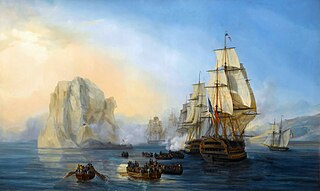
A stone frigate is a naval establishment on land.

His Majesty's Naval Base, Portsmouth is one of three operating bases in the United Kingdom for the Royal Navy. Portsmouth Naval Base is part of the city of Portsmouth; it is located on the eastern shore of Portsmouth Harbour, north of the Solent and the Isle of Wight. For centuries it was officially known as HM Dockyard, Portsmouth: as a Royal Dockyard, Portsmouth functioned primarily as a state-owned facility for building, repairing and maintaining warships; for a time it was the largest industrial site in the world.

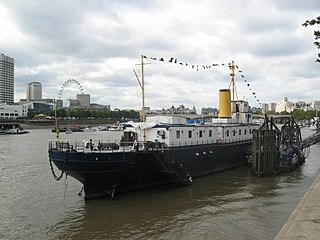
HMS President is a retired Flower-class Q-ship that was launched in 1918. She was renamed HMS President in 1922 and moored permanently on the Thames as a Royal Navy Reserve drill ship. In 1982 she was sold to private owners and, having changed hands twice, served as a venue for conferences and functions as well as the offices for a number of media companies. She has been moved to Chatham on the Medway in Kent since 2016, but is due to return to the capital. She had the suffix "(1918)" added to her name in order to distinguish her from HMS President, the Royal Naval Reserve base in St Katharine Docks. She is one of the last three surviving Royal Navy warships of the First World War. She is also the sole representative of the first type of purpose built anti-submarine vessels, and is the ancestor of World War II convoy escort sloops, which evolved into modern anti-submarine frigates.

HMSGannet is a Royal Navy Doterel-class screw sloop-of-war launched on 31 August 1878. It became a training ship in the Thames in 1903, and was then loaned as a training ship for boys in the Hamble from 1913. It was restored in 1987 and is now part of the UK's National Historic Fleet.

The Thames Nautical Training College, as it is now called, is a school that trains officers for a seagoing career. It was, for over a hundred years, situated aboard ships named HMS Worcester. London shipowners, marine insurance underwriters and merchants subscribed to its founding. It was the London maritime interests' answer to HMS Conway, which had been established in 1859 on the River Mersey as a training ship for Liverpool's burgeoning merchant fleet. Throughout their history, Worcester and Conway were competitors, and the two met regularly on playing fields and in boats in keen sporting rivalry.

The Kingston Royal Naval Dockyard was a Royal Navy Dockyard from 1788 to 1853 in Kingston, Ontario, Canada, at the site of the current Royal Military College of Canada.
Eight ships and a training establishment of the Royal Navy have borne the name HMS Worcester, after the English city of Worcester:

HMS Impregnable was a 104-gun first rate three-decker ship of the line of the Royal Navy, launched on 1 August 1810 at Chatham. She was designed by Sir William Rule, and was the only ship built to her draught.

HMS St Vincent was a 120-gun first-rate ship of the line of the Royal Navy, laid down in 1810 at Devonport Dockyard and launched on 11 March 1815.
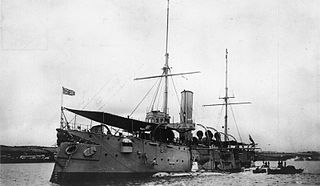
HMS Thames was a Mersey-class protected cruiser built for the Royal Navy (RN) in the 1880s. The ship was placed in reserve upon her completion in 1888 and was converted into a submarine depot ship in 1903. She was sold out of the navy in 1920 and was purchased by a South African businessman to serve as a training ship for naval cadets under the name SATS General Botha. The ship arrived in South Africa in 1921 and began training her first class of cadets in Simon's Town the following year. General Botha continued to train cadets for the first several years of World War II, but the RN took over the ship in 1942 for use as an accommodation ship under her original name. She was scuttled by gunfire in 1947 and is now a diveable wreck.

HMS President is a "stone frigate", or shore establishment of the Royal Naval Reserve, based on the northern bank of the River Thames near Tower Bridge in Wapping and is in the London Borough of Tower Hamlets.
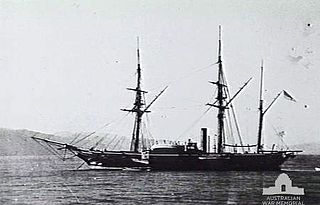
HMS Virago was a Royal Navy Driver-class wooden paddle sloop launched on 25 July 1842 from Chatham Dockyard.

HMS Arethusa was a 50-gun fourth-rate sailing frigate of the Royal Navy launched in 1849 from the Pembroke Dockyard. The fourth naval ship to bear the name, she served in the Crimean War and then in 1861 was converted to a steam screw frigate. Decommissioned in 1874, Arethusa became a school and training ship on the River Thames, preparing young boys for maritime careers, until she was broken up in 1934.
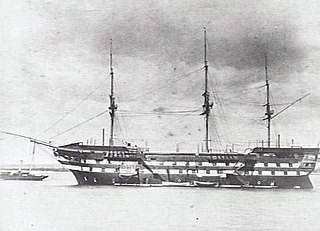
HMS Frederick William was an 86-gun screw-propelled first-rate ship of the line of the Royal Navy.

The South African Naval College provides naval officer training to the South African Navy and is one of three officer training institutions within the South African National Defence Force, the equivalent of the Air Force Gymnasium and the Army Gymnasium



















